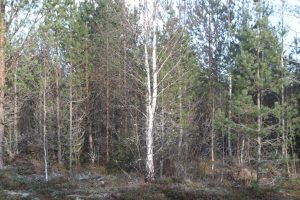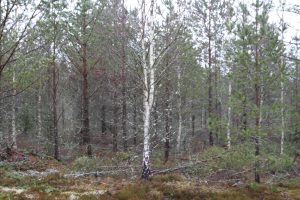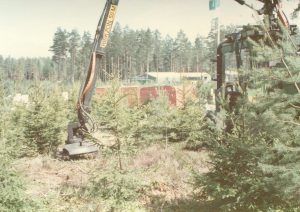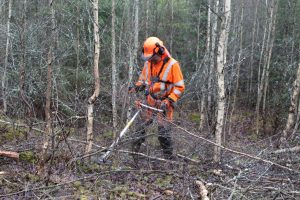As mentioned in the article Swedish Forestry #3 there are, in the more or less totally mechanized Swedish forestry, parts where the mechanization just doesn´t break thru, not yet anyway. Reforestation is one, another one is pre-commercial thinning.
In the shade of the development of machines for harvesting and forwarding there were also some attempts to mechanize pre-commercial thinning (PCT – thinning where trees are felled but left on the ground in the forest to create better conditions and growth for the trees that are left standing). Already by the middle of the 19th century it was realized that to maintain a good flow of timber for the Swedish forest industry, it was necessary to regenerate and manage the forests from the start. To gain logs in wanted diameters the forest managers learned that you have to choose the main stems very early and give those the best conditions to grow, and at the same time remove “unwanted” trees.
To get the right qualities and quantities by the time for clear-cutting, it´s necessary to do PCT at least once before the plants grow into be trees. Also, the first commercial thinning is important for the same reason, but in that case, the forest owner can count on some income that makes the action easier to motivate.
To finance the development of machines for tree harvesting seemed to be easy; To get the timber from the forest to the mills faster was a financially good thing and motivator that is easy to understand. PCT was, and still is, a pure cost which could be one reason that the mechanization of it never really has taken off. Another reason is, as for planting, that the collapse of the iron curtain in the early 90´s made it possible for workers from the former east block to come over to the west to work in the forest and make good money.
There were some tries
During the 70´s and the 80´s, before the iron curtain came down, and because local labor was expensive and difficult to get, there were some trials with different kinds of bush cleaning machines. There were both modified harvesters and forwarders, like this Mini Brunett …
… but also purpose built machines like this Häglinge Jumbo at the Elmia show in 1989
There were also a number of other prototypes and experiments but none of them ever made success, partly because of the cheap labor from the east. Another reason was that the machines didn´t offer the needed accuracy not to damage the trees left standing. We have to bear in mind that the PCT is supposed to form the future forest to make it as profitable as possible when the final harvest comes. So, it´s very important that the trees left standing are in their best condition.
By the end of the day, just like with planting, human power with a cleaning saw or a brush cutter was, and still is the best and most profitable solution.
The most common methods
The by far most common method to do PCT is with a clearing saw like on this photo.
Depending on how dense the stand is, a skilled forest worker can do 0,5 – 1 hectare (1,25 – 2,5 acres) per day with one of those. The clearing saw is flexible, and the accuracy is excellent compared to a forest machine. The operator can easily choose the main stems and give them enough space to develop and become the future forest.
Approximately 420 000 hectares PCT (2017) is done annually in Sweden. Most likely, more could, and should, be done to reach a satisfying level, but this has not been confirmed when looking at official statistics.
Bioenergy competed with the pulp mills
From approximately 2006 to 2011 there was a boom for bioenergy from the forest in Sweden. A number of solutions to take out biomass instead of pulpwood from young stands in commercial thinning’s entered the market. With many of those small felling heads, it was also possible to cut very thin stems that could be used for bioenergy production. For a while the optimists claimed that PCT actually could be profitable for the forest owners, even more profitable than taking out pulpwood.
However, after 2011 biomass prices went down and the pulp industry took the command over the wood again. It also has to be said; To take biomass out of young stands was dependent on a good volume, meaning that the very thinnest stems never were interesting. So to claim that PCT was profitable, if only for a short while, could be slightly exaggerated.
The purpose-built biomass felling heads that are still on the market today are mainly used to clean power lines, road- and field sides, not so much to do thinning.
Mechanized PTC today
There are a number of crane tip mounted applications for PCT on the market. The question is if the precision of the work they do is enough considering damages on the stems that are left standing? The impression is that this kind of machines are mainly used for power line clearing and similar.
One method that has been tried in research projects is corridor cleaning where a mulcher or a grinder is used to make corridors in the stand, leaving stripes of trees to be the future stand. This is a very efficient method, but the quality of the result can be discussed.
What comes ahead?
Mechanized PCT by loosening the root system is being tried by the Forest Research Institute of Sweden, Skogforsk. That means the small unwanted trees are simply pulled up by a machine.
A fully mechanized system for PCT seems, however, to be far away, much further away than mechanized planting that we wrote about in the article Swedish Forestry #3 .
Sources: Swedish Forest Agency (Skogsstyrelsen), Skogforsk (the Forestry Research Institute of Sweden), Södra, SLU
Photos: Per Jonsson and Carina Johansson



















